Update 5-11-17: What Graphics Card Should You Get?
The GeForce GTX 1080 was one of the worst kept secrets in graphics hardware. While many leaked images hinted at the new card's arrival, it still came as a surprise when manufacturer Nvidia announced that the GTX 1080 would not only be faster than the $1,000 Titan X, but apparently faster than two GTX 980s in SLI.
It's difficult to recall the last time a new flagship GPU from Nvidia was as fast as two of its predecessors in SLI. And you supposedly get all of this for a starting price of $599? Surely there's a catch?
While the GTX 1080 doesn’t eclipse two 980s in every scenario, it's demonstrably stronger at 4K. That makes this, right now, the fastest single-GPU card about to hit the market.
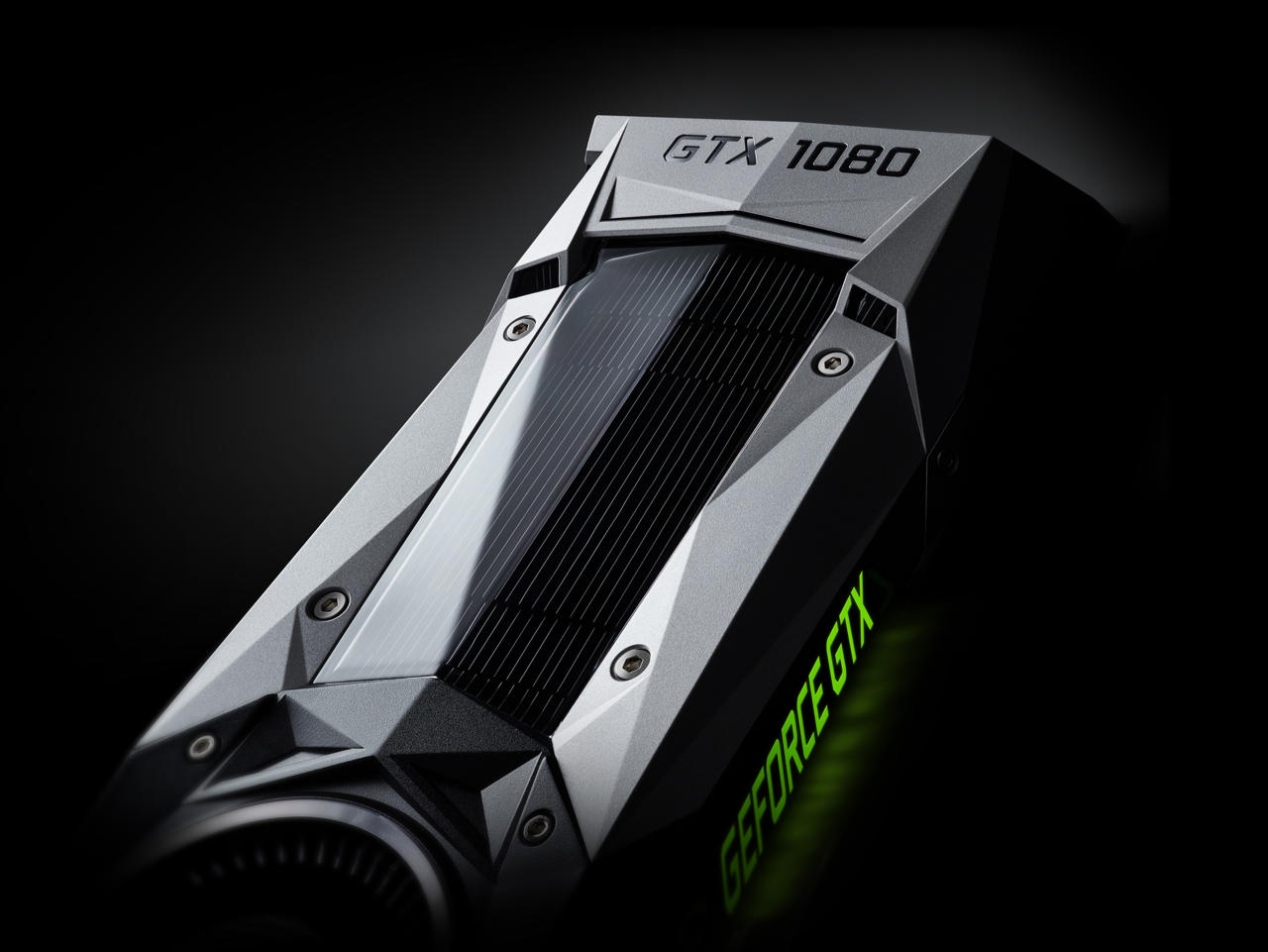
Design
I'm reviewing the “Founders Edition” of the card, which cost $699 ($100 more than the 1080’s starting price). While previous iterations from Nvidia were known as “reference designs,” it appears the corporation wants to show it designs more than baseline graphics cards. So it has revamped its own design by using higher-quality materials that will no doubt resonate with the most devoted enthusiasts . Having said that, the Founders Edition graphics card does not use a higher-quality binned GPU. The extra $100 is merely for the superior materials and craftsmanship. For what it's worth, personally I find the card’s jagged edges look pretty sharp.
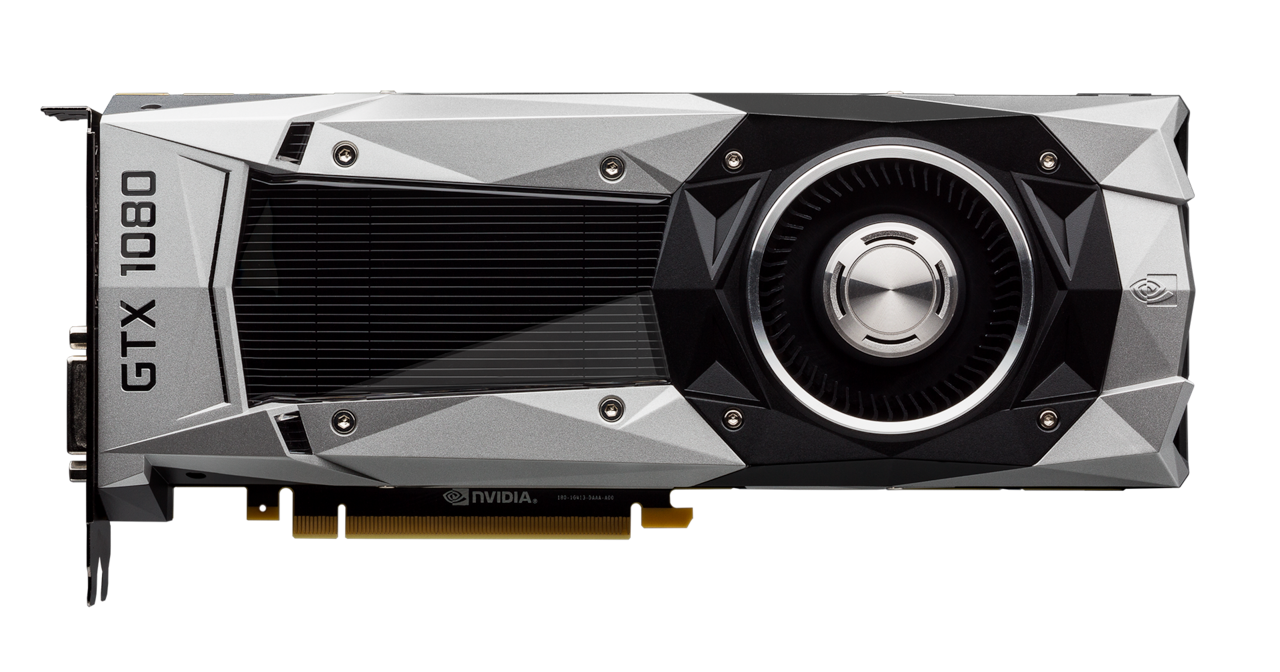
What makes the Founders Edition stand out? For starters, the 4.3x10.5-inch chassis uses a die-cast aluminum body. The two-slot card’s radial blower fan is also aided by Nvidia’s vapor chamber cooler. Under load, I saw the fan rev up to 1,342rpm, which was still near whisper quiet.
Another feature that makes the Founders Edition different is its removable low-profile backplate, which is useful for snug SLI configurations.
Specs
GeForce GTX 1080 also uses a new video RAM built by Micron called GDDR5X, which is currently the fastest GDDR memory on the market
Founders Edition details aside, all GeForce GTX 1080s use Nvidia’s new Pascal architecture, which leverages bandwidth reduction, preemption, and memory compression techniques to become the company’s most efficient architecture to date. On top of this is a new 16nm FinFET production process, which ultimately allows the card’s clocks to run really high (I witnessed a base clock of 1.61GHz and a boost clock of 1.73GHz.) Nvidia says it’s also been able to overclock the card to over 2GHz. For reference, the company has not before been able to surpass 2GHz on any of its cards, whether using air cooling or more efficient water coolers.
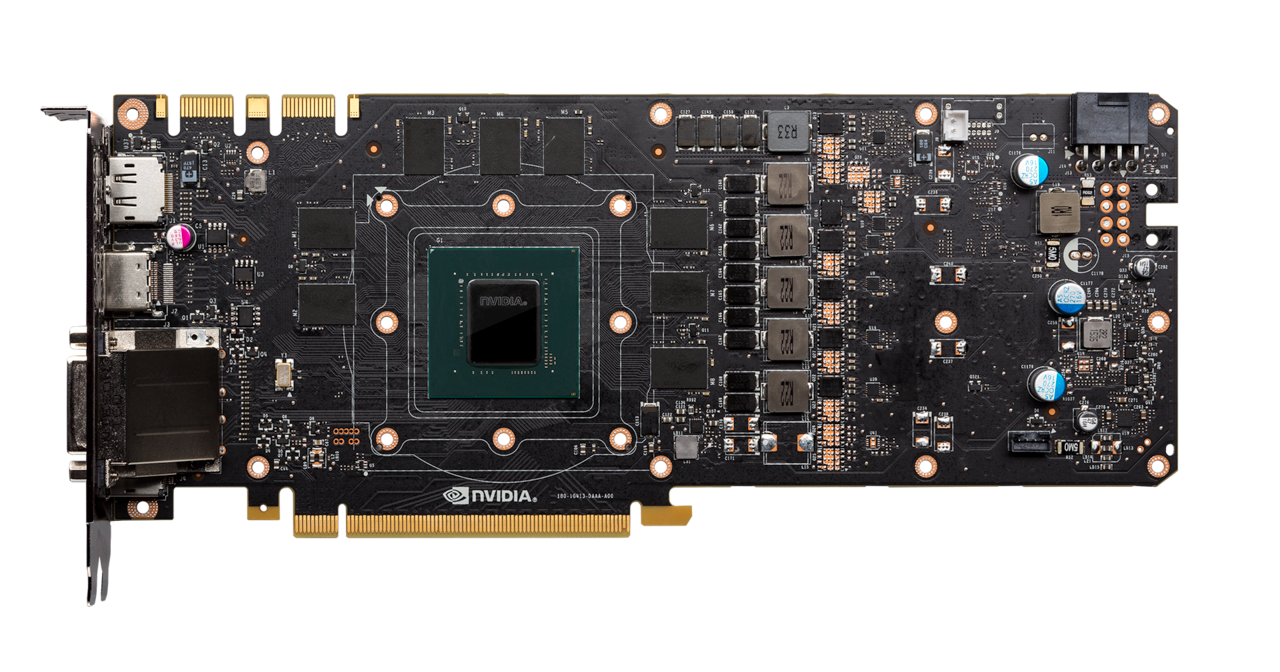
The GeForce GTX 1080 also uses a new video RAM built by Micron called GDDR5X. G5X, as it’s also known, is currently the fastest GDDR memory on the market, and allows the card's VRAM to reach an exceptional 10GHz. For reference, the GTX 980 before it topped off at 7GHz.
The GTX 1080 uses a generous 8GB of that frame buffer, which positions it in 4K territory, and is double the VRAM of its 2014 predecessor, the GTX 980.
Spec Chart
| GTX 1080 | GTX Titan X | GTX 980 Ti | GTX 980 | |
|---|---|---|---|---|
| CUDA Cores | 2560 | 3072 | 2816 | 2048 |
| Texture Units | 160 | 192 | 176 | 128 |
| ROPs | 64 | 96 | 96 | 64 |
| Core Clock | 1607MHz | 1000MHz | 1000MHz | 1126MHz |
| Boost Clock | 1733MHz | 1075MHz | 1075MHz | 1216MHz |
| Memory Clock | 10GHz GDDR5X | 7GHz GDDR5 | 7GHz GDDR5 | 7GHz GDDR5 |
| Memory Bus Width | 256-bit | 384-bit | 384-bit | 256-bit |
| VRAM | 8GB | 12GB | 6GB | 4GB |
| TDP | 180W | 250W | 250W | 165W |
| GPU | GP104 | GM200 | GM200 | GM204 |
| Architecture | Pascal | Maxwell | Maxwell | Maxwell |
| Transistor Count | 7.2 billion | 8 billion | 8 billion | 5.2 billion |
| Manufacturing Process | 16nm FinFET | TSMC 28nm | TSMC 28nm | TSMC 28nm |
| Launch Date | 05/27/16 | 03/17/2015 | 06/01/2015 | 09/18/2014 |
| Launch Price | $599/$699 | $999 | $649 | $549 |
But what does all this new tech mean for power consumption? With the more power-efficient design, the GTX 1080 carries a modest 180-watt TDP (thermal design power), and only requires one eight-pin power connector. This is really lightweight when you compare it to the reference 980 Ti’s 250-watt TDP, which is a card that requires both an eight and six-pin connector.
Features
Every time a new GPU architecture from Nvidia rolls around, the company likes to incorporate new graphical features, the situation is no different with Pascal.
Ansel
Arguably the most interesting addition is Ansel. Named after famed photographer Ansel Adams, the new feature is a free-roaming camera that allows you to pause a game’s action and take a high-resolution screenshot (with the UI stripped out). While that description may sing to the budding videogame photographer in you, it actually sells Ansel a little short, since there are also a ton of post-processing effects that you can add to your image that include film grain, bloom, lens floor, vignettes, and more.

Perhaps more impressive is that Ansel uses a CUDA-based imaging stitcher that can stitch up to 3600 tiles for a photo that scales up to 4.5 gigapixels. That equates to an EXR file that’s roughly 1,000 times sharper than 4K. It’s a really sophisticated tool that not only allows you to save 360-degree images, but stereoscopic 360-degree images that you’ll be able to revisit in VR using anything from the $800 HTC Vive to the inexpensive Google Cardboard.
However, this tech only works for games that allow it, but Nvidia claims that developers should find it easy to incorporate. Apparently, to get Ansel working with The Witness, it took only 40 lines of code. Other games that will support Ansel include The Division, LawBreakers, The Witcher 3, Paragon, No Man’s Sky, and Unreal Tournament.
VRWorks Audio
With modern VR now a reality, Nvidia wanted to change how people listen to spatialized audio. While the industry has been able to nail down directional audio to a satisfactory degree in traditional video games, modern audio solutions don’t quite cut it for VR. To mimic lifelike audio in VR, audio needs to reverberate off walls and echo appropriately. Coming up with a solution to this problem could greatly enhance virtual-reality immersion.
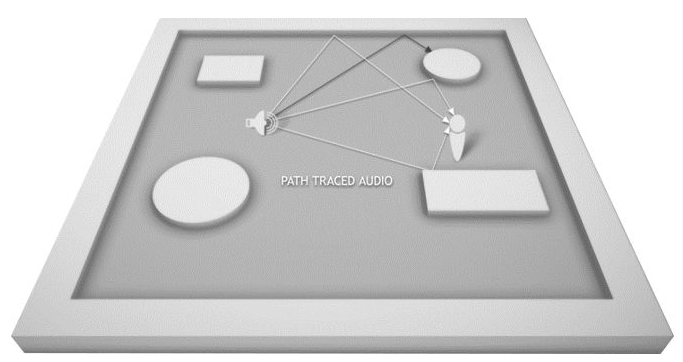
Nvidia’s solution is VRWorks Audio, which the company enthusiastically exclaims is the “world’s first real-time acoustics simulator.” The technology essentially leverages the GTX 1080’s ability to calculate complex physics to realistically bounce audio off of virtual environments.
I’ve only briefly tried one VRWorks Audio demo at a controlled Nvidia press event, and would like to do more AB testing to come to a conclusion on how well it works.
Simultaneous Multi-Projection
Because display types and resolutions are constantly evolving, Nvidia created what it calls “Simultaneous Multi-Projection” to be adaptable to the times. SMP uses 16 independent “viewports” to appropriately re-composite an image to its display type. For instance, if you’re going to game with three monitors in Nvidia Surround, chances are you’re going to want to angle the peripheral monitors inwards so you can get a better sense of your virtual surroundings. A negative side- effect to this is that because the game doesn’t know you’re turning the monitors inward, it inadvertently creates this weird and inaccurate image distortion. SMP fixes this by warping and rendering a wider FOV to compensate for the angle change.
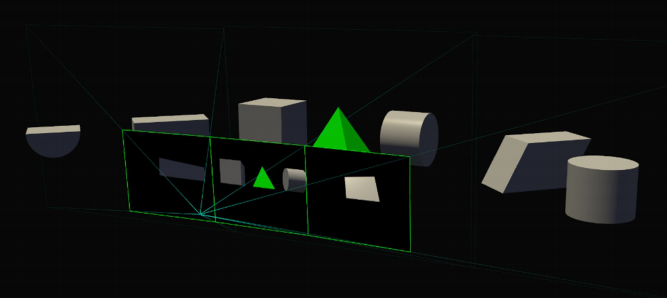
Nvidia also says that SMP can provide a performance boost for virtual reality. Instead of rendering a monster twice for each eye in VR, for instance, SMP, in theory, allows the GTX 1080 to do one single rendering pass of the monster and displays two different viewports from that pass that mimic the positions of both our eyes.
HDR
High-dynamic range monitors are said to be the “next big thing” for displays. HDR increases the visible colors of traditional monitors by a factor of two. According to Nvidia, that covers roughly 75 percent of the visible color spectrum. Nvidia is positioning its Pascal GPUs to take advantage of this richer HDR color gamut. Games will have to be optimized to work with HDR, however, and some titles that will support it include The Witness, Lawbreakers, Rise of the Tomb Raider, Paragon, and Shadow Warrior 2.

Fast Sync
With the GTX 1080, Nvidia is also introducing a GPU/display feature called “Fast Sync.” It's a complementary feature to the company’s G-Sync technology, but does not require a G-Sync monitor. The benefits of Fast Sync come into play at the higher end of the performance spectrum, when your GPU is able to render frames faster than your monitor’s refresh rate. Enabling Fast Sync here, in theory, would allow you to get near the low latency of having V-Sync disabled, but without the annoying screen-tearing effects.
GPU Boost 3.0
The last noteworthy feature the GTX 1080 introduces is GPU Boost 3.0, which allows you to adjust the per-voltage point frequency offset. This allows you to match the card’s frequency against its voltage more closely. If you’re really into the minutia of GPU overclocking, this can be pretty exciting.
1080P Benchmarks
Performance
While the new bells and whistles seem nice, the real acid test is how fast the GTX 1080 runs. Let’s take a look at the benchmarks.
Methodology
For our test bench, I'm using a PC equipped with an Intel Core i7 5930K CPU clocked at 3.5GHz along with 16GB of RAM. I've used a wide array of game benchmarks along with some synthetic tests at three resolutions (1080p, 1440p, and 4K).
I'm pitting the GTX 1080 against the GTX 980, its predecessor, and because Nvidia claimed that the GTX 1080 is faster than two 980s in SLI, we’re testing it against that, too. Nvidia also claimed that the GTX 1080 is faster than the GTX Titan X. Unfortunately, we don’t have a Titan X on hand, but we do have the next best thing, and perhaps something that is even better: Zotac’s GeForce GTX 980 Ti Amp! Extreme. The GeForce GTX 980 Ti is already almost as fast as the Titan X, but Zotac’s supercharged version is a massive three-slot card that has three fans along with massive heat sinks to accommodate the extra overclock. Compared to its vanilla counterpart, it carries a 253MHz faster core clock and a zippier 279MHz boost clock. On top of that, it’s VRAM is also clocked 210MHz higher and the card is 25 watts beefier than the stock 980 Ti. In many cases, it’s actually at least 10% faster than a Titan X.
Because there is a lot of GPU horsepower here, to properly push the cards, all benchmarks are set to their respective max settings.
1080p Benchmarks
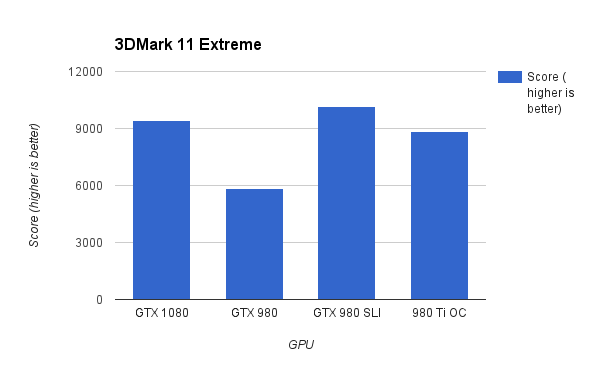
Clearly, this card is overkill for 1080p gaming.
3DMark 11 is a popular system benchmark tool that is heavily graphics-intensive and leverages DirectX 11. We ran the benchmark under the Extreme setting. As you can see from the graph above, the GTX 1080 is the fastest single-GPU setup with a 9441 score. Nvidia’s claim that the GTX 1080 is faster than two 980s doesn’t quite hold up under this resolution, but it is important to note the the Extreme mode renders scenes at 1080p, which is a resolution that is too low to awaken the GTX 1080’s monstrous VRAM from its slumber.
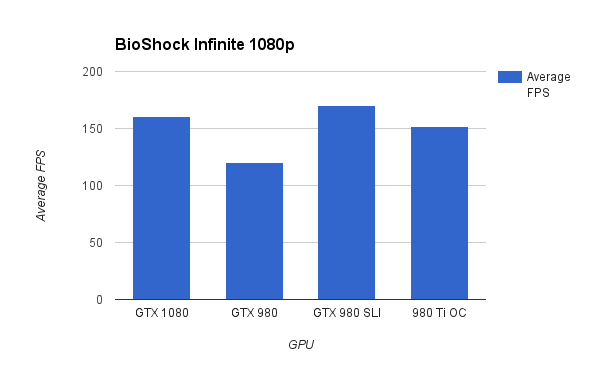
Using the Unreal Engine 3, BioShock Infinite is a moderately-taxing game, but at 1080p, the GeForce GTX 1080 renders Irrational Games’ shooter with a 160.7 average FPS. Clearly, this card is overkill for 1080p gaming. The GTX 1080 is 5% slower than the pair of 980s, but *spoiler warning* you’ll see the GTX 1080 overtake the dual cards at the higher resolutions, where the pair of 980s are held back by the fact that they can’t combine, or “stack,” their 4GB frame buffers.
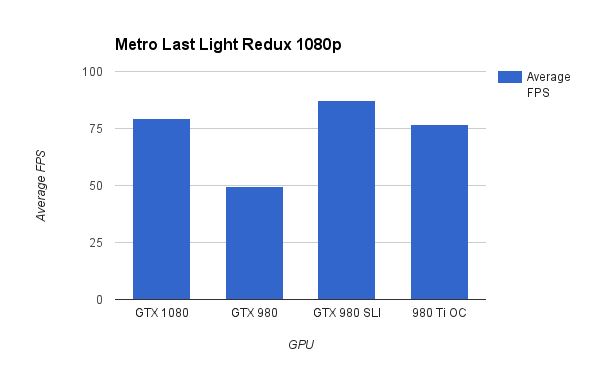
The GTX 1080 trumps all single GPU configurations and is once again only bested by the dual 980s. To be fair, the Metro Last Light benchmark pushes a ton of graphical effects that include advanced lighting, smoke, and physics elements that will eat up all the computational power that two GPUs will be able to throw at it.
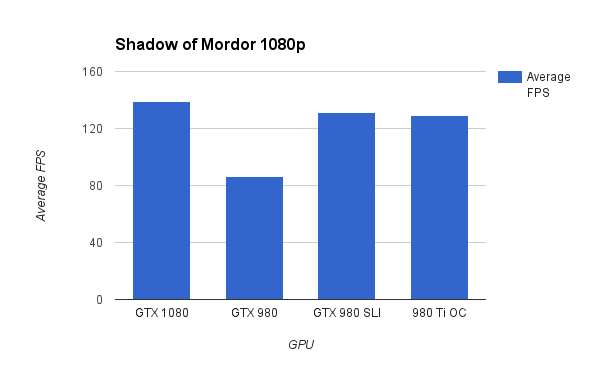
Middle Earth: Shadow of Mordor is the only 1080p benchmark where the GTX 1080 beats the dual 980s. Why is that? Because I benchmarked the game using the HD texture pack, which meant the GTX 1080’s 8GB of GDDR5X memory was finally able to get a little workout.
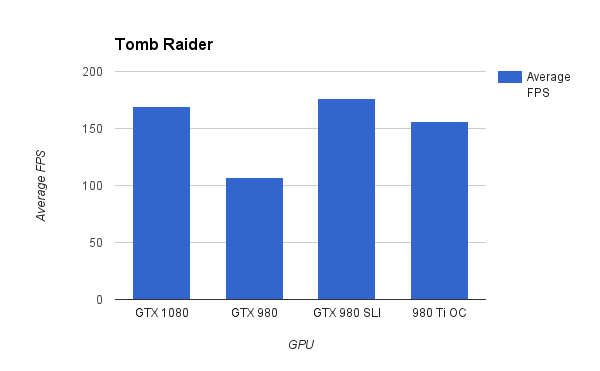
You should begin to see a trend here. At 1080p, the GTX 1080 is consistently ahead of the overclocked 980 Ti (and by extension the Titan X and GTX 980) and is generally only slightly bested by the two 980s.
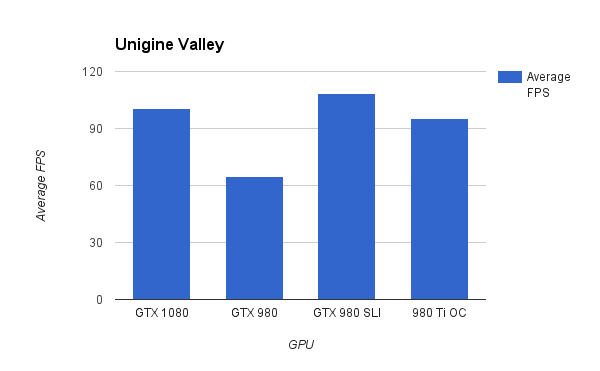
Unigine Valley is a heavily graphics-intensive synthetic benchmark that uses the Unigine engine. This test affirms that the GTX 1080 isn’t quite as fast as two 980s at 1080p, but nonetheless carries high average FPS of 100.7.
1080p Conclusion
At 1080p, the GTX 1080 generally isn’t faster than two GTX 980s in SLI
At 1080p, the GTX 1080 generally isn’t faster than two GTX 980s in SLI, but that’s because the resolution is too low for the GTX 1080’s 8GB of GDDR5X to even awaken. The GTX 1080 is like a super fast race horse that is tied down by the weight of a low resolution. Sure, it can still push the chariot superfast, but two slightly slower horses (the 980s) can generally do the job five to nine percent faster. Still, considering you can get similar levels of performance here for several hundreds of dollars less is extremely impressive.
Perhaps the bigger takeaway is that you should not get the GTX 1080 if you plan on using a 1080p monitor. Unless you aim to use a 144Hz or 165Hz super high refresh-rate monitor, it’s simply overkill.
1440p Benchmarks
1440p Benchmarks
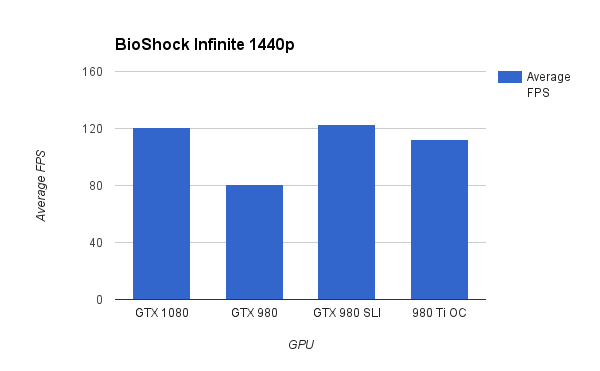
Whereas the dual 980s were able to enjoy a cushy 5 percent lead in the BioShock Infinite benchmark at 1080p, the GTX 1080 has made up ground at 2560x1440, where frame buffer size is beginning to matter more. Now the SLI setup only leads by a one percent margin, but still leads nonetheless.
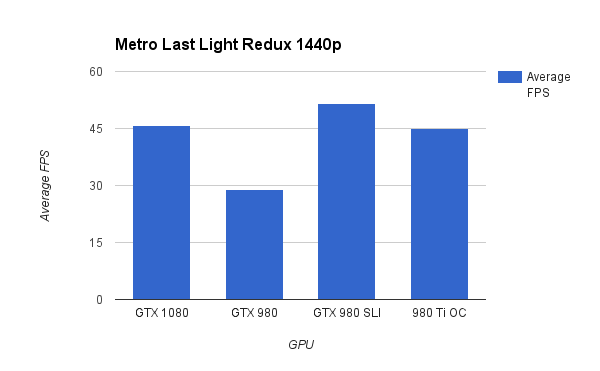
While the GTX 1080 was able to make some ground in BioShock Infinite at 1440p, victory is just as elusive at this resolution in Metro Last Light for the GTX 1080. While Nvidia’s new flagship graphics card has double the amount of VRAM as the dual 980 setup, and should be able to beat it in a battle of textures as a result, the Last Light benchmark again isn’t so texture-intensive as it is effects-heavy.
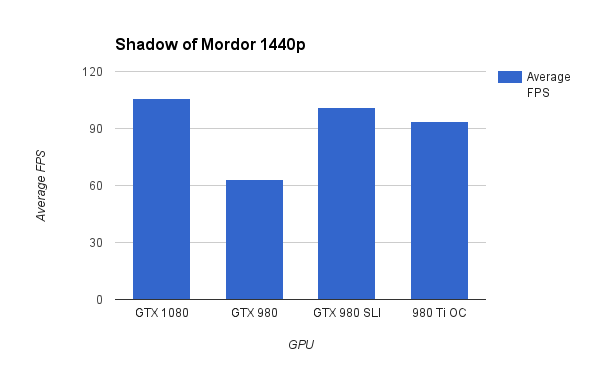
Because Shadow of Mordor uses high-resolution textures, the GTX 1080’s 8GB of GDDR5X VRAM is once again able to out-leverage the dual 980s.
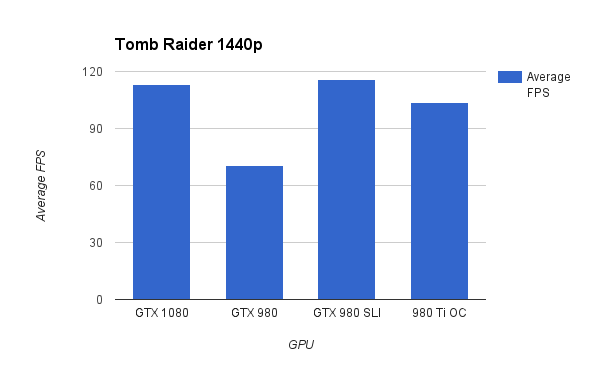
At 1080p, the GTX 1080 lost to the dual 980s by four percent, but here at 1440p, the Pascal card is able to close the gap down to two percent.
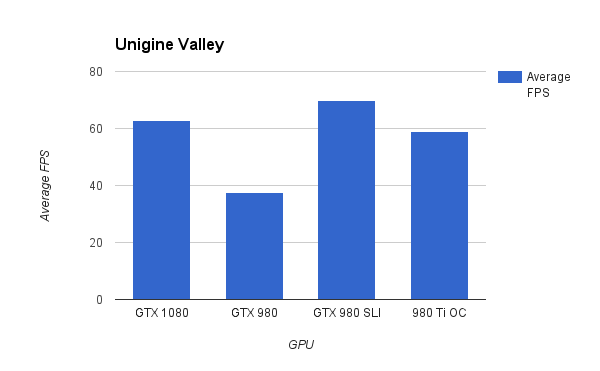
If your goal is to max out 1440p games with at least a 30 FPS average, then the GTX 1080 will be able to handle that with relative ease.
Even though I'm testing the GTX 1080 against two 980s, it’s worth pointing out the giant delta between the GTX 1080 against a single 980 in this test. The GTX 1080 is able to enjoy a 62.8 average FPS here, whereas the 980 has a much lower 37.6 average FPS. That’s a 67 percent performance gap and means the difference of gaming at 30 something FPS vs 60 something FPS.
1440p Conclusion
If your goal is to max out 1440p games with at least a 30 FPS average, then the GTX 1080 will be able to handle that with relative ease. Even under the brutal Metro Last Light benchmark, which is one of the most graphically-demanding games around, it garnered a very playable 45.6 average FPS. This suggests that GTX 1080 may be powerful enough to perform at 4K, which is something few single-GPU cards have been able to achieve.
2160P (4K) Benchmarks
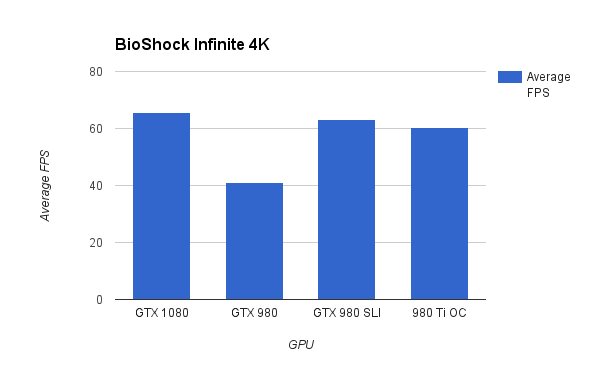
Up until now, the GTX 1080 has been trying to play catch up to the dual 980s in our BioShock Infinite benchmark. Now, in the realm of 4K, the card and its 8GB of GDDR5X video RAM can just about cross the finish line with a four-percent lead. Perhaps more important is that it’s able to play BioShock Infinite maxed out at 4K with a smoother-than-60 (65.5) average FPS, which is quite the accomplishment.
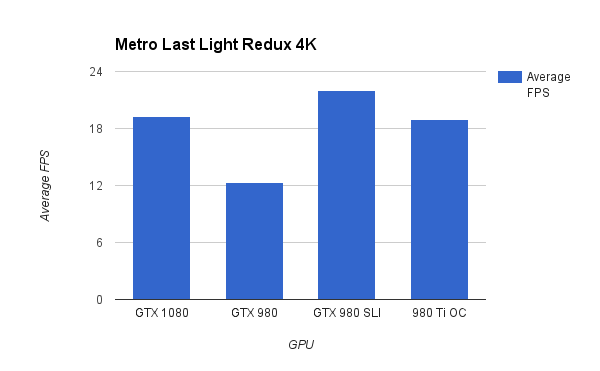
Metro Last Light is the only 4K benchmark in which the GTX 1080 isn’t able to outperform the dual 980s. It’s likely all those crazy special effects that are too much for the single GPU to handle, with the game rendering at an unplayable 19.3 FPS. To be fair, even two 980s are only able to muster a 22 FPS average, which is also not playable.
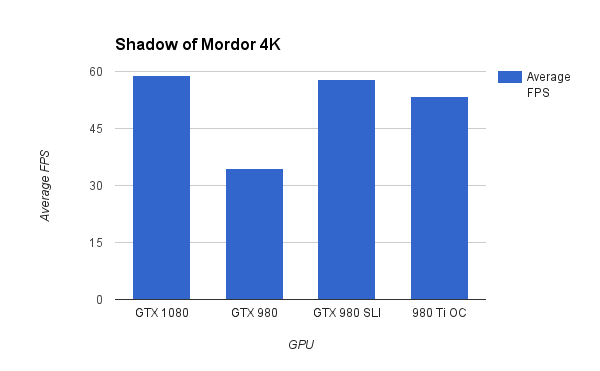
The GTX 1080 appears to edge ahead here, but the really big thing to focus on is the disparity between the GTX 1080 and single 980. While the GTX 980 is able to muster a playable 34.6 average FPS, that’s 71 percent slower than the GTX 1080’s 59 FPS average. One graphics card has you playing in the 30s, while the other has you almost at 60FPS.
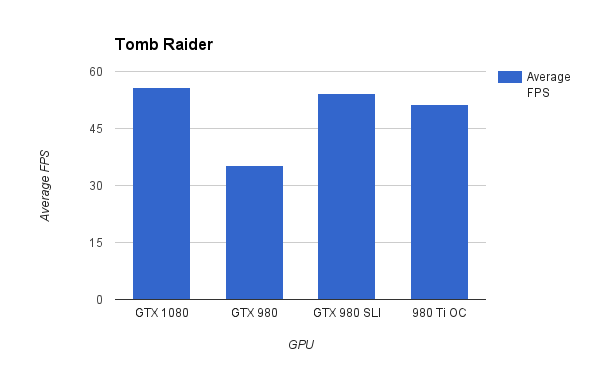
What was a narrowing two-percent deficit at 1440p has grown to a three-percent lead for the GTX 1080 over the dual 980s. And with an average FPS of 55.7, Tomb Raider is most definitely playable maxed out at 4K.
4K Conclusion
Experientially, the GTX 1080 will be able to handle most games maxed out at 4K with above 30 average FPS
Clearly, the GeForce GTX 1080 is a 4K-capable card. Will it be able to max out every single game at 3840x2160? No, but that’s a lot to ask of any single graphics card. Experientially, the GTX 1080 will be able to handle most games maxed out at 4K with above 30 average FPS, which is quite the feat. If you’re looking to max out graphically-demanding games at 4K with 60 plus FPS, you’ll need at least two graphics cards.
VR Test
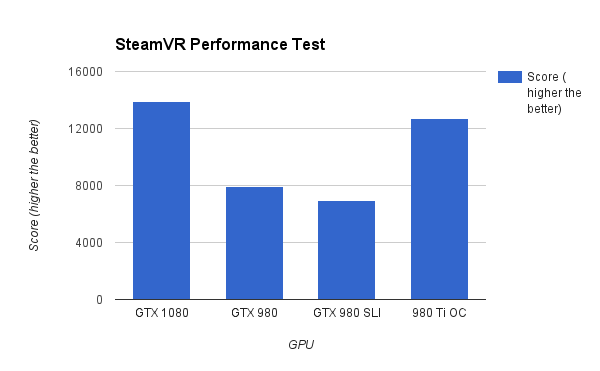
With VR picking up steam (no pun intended) and being so graphically-intense having to run two independent 1080x1200 resolution screens at 90FPS, it's wise to see how the GTX 1080 would handle a VR workload.
While there aren’t very many VR benchmarks out there at the moment, Valve did recently release its SteamVR Performance Test, which benchmarks systems using its Aperture Science VR demo.
Because framerate is so essential to VR (if it dips below 90fps, you are more likely to get motion sick), the more frames a graphics card can generate, the better the experience.
The GeForce GTX 980 is a really good card for VR and is actually above both Oculus Rift’s and HTC Vive’s recommended spec (both recommend a GTX 970). The GTX 1080, on the other hand, is an exceptional card for VR and is a whopping 58 percent faster than the 980 with a 13921 frame count.
While the dual 980s were able to trade blows with the GTX 1080 in most of our previous tests, you’ll notice that the SLI setup is actually the worst of the bunch here. The reason for that is most VR demos, including the SteamVR Performance Test here, are not optimized for SLI. As a matter of fact, because SLI introduces latency, with the two cards having to communicate with each other, VR performance actually suffers.
Overclocking
According to Nvidia’s internal testing, the company was able to overclock the GTX 1080’s core clocks up to 2.1GHz under load. Using a prerelease version of EVGA Precision that was provided by Nvidia, I wasn't able to duplicate the results in our initial testing. I was, however, able to crank GPU clocks up by 200MHz with stable results. It is important to note that every single GPU is going to overclock differently, even GPUs within the same SKU (due to complicated and intricate binning processes). You can expect a more in-depth GTX 1080 overclocking story on GameSpot in the near future, but for now, know that the GTX 1080 does provide some overclocking runway.
Conclusion
The GeForce GTX 1080 is the fastest single GPU-graphics card available today. It easily gives the $1,000 Titan X a run for its money. At 4K, where it’s really able to flex its muscles, it can be 70 percent faster than its predecessor, which is insane when you consider that the GTX 980 is still a fantastic GPU.
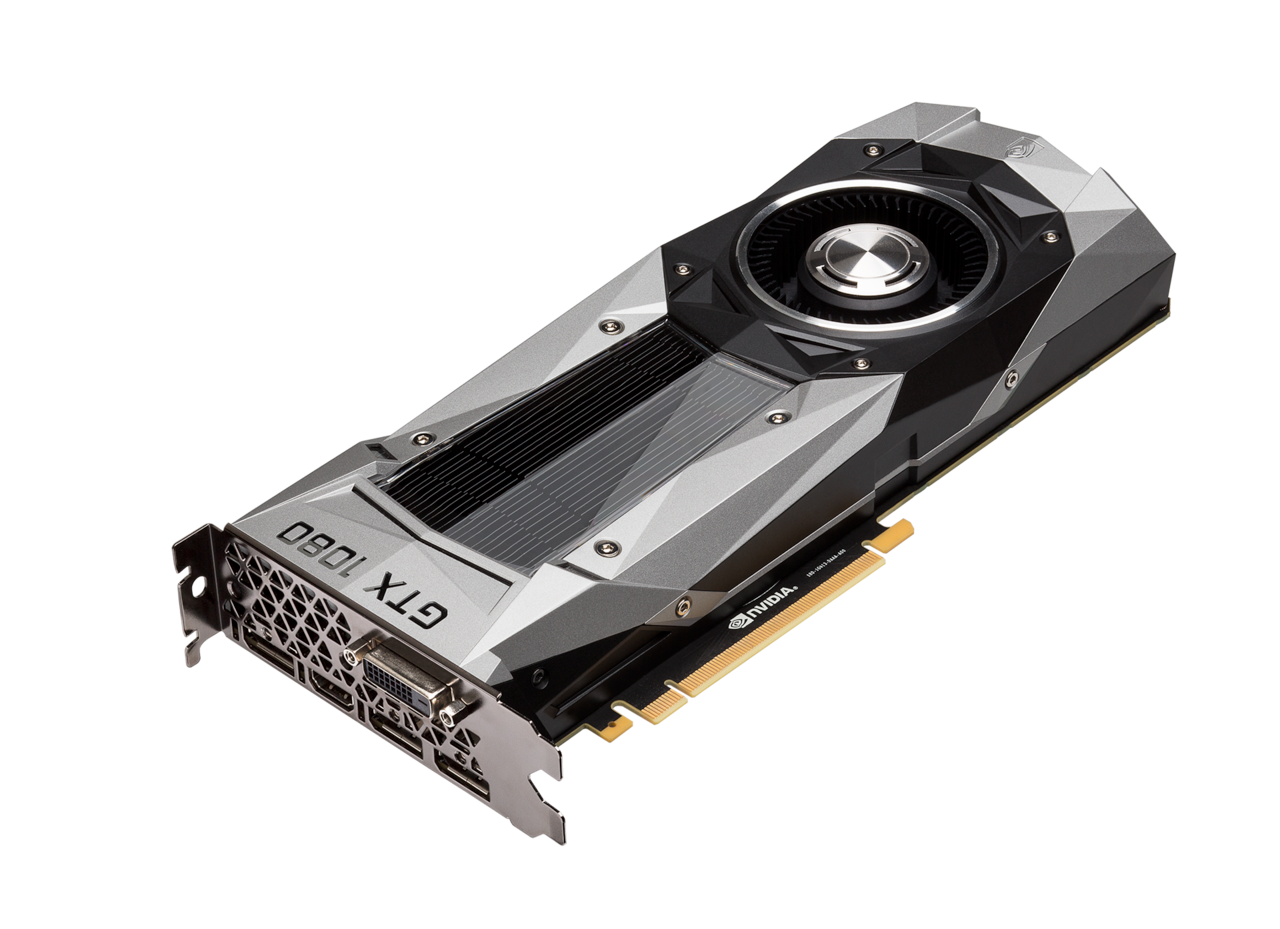
The GTX 1080 offers a new single-card performance standard at great value.
If the GTX 1080 is out of your price range, you’ll want to keep your eye out on the GTX 1070, which releases on June 10th. Nvidia claims that the 1070 is as fast as the Titan X, but will start at a much more reasonable $379.
No, it won’t max out every single game at 3840x2160 with smooth playable frame rates. Don’t expect a single-GPU card to be able to smoothly max out 4K until at least Nvidia’s Volta architecture arrives, which looks to be around 2018. Regardless, the GTX 1080 offers a new single-card performance standard at great value.
